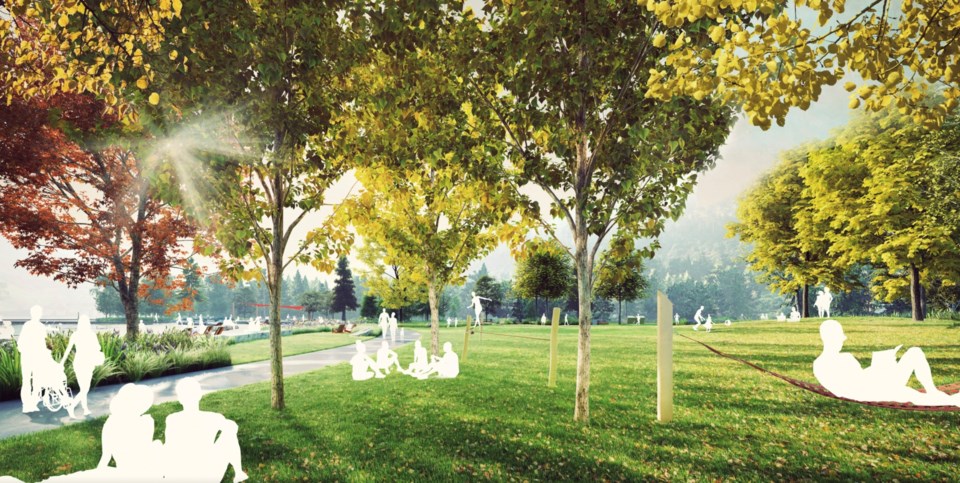A new online petition is rapidly gathering support in its call to review the second phase of planned upgrades to Rainbow Park, set to begin later this year.
Launched on Jan. 23 by local tobias c. van Veen, the petition gathered more than 1,000 signatures in two weeks. The aim is to have the municipality review the planned redesign of the park and do more community engagement before breaking ground.
van Veen’s primary reason for launching the petition concerns the addition of more paving in the park. He takes particular issue with the planned widening and extension of the Valley Trail, the creation of a new beachfront promenade, and a paved food truck plaza.
“I want as wild as possible, accessible as possible, to the point of remembering it is still a natural park, green space,” van Veen said. “I think that Rainbow Park should preserve its cultural heritage and it should protect its natural state, and any upgrades should be based upon those two fundamental principles.”
The planned upgrades will make substantial alterations to the layout and design of the park, which exploded in popularity during the COVID-19 pandemic.
The upgrades will expand the small natural beachfront into a more extensive, sandy beach; create a new dock and hammock space; incorporate a paved food truck plaza; and expand the Valley Trail in the park alongside the beach, in addition to infrastructure improvements to fix the park’s drainage, irrigation and sewer system.
The beachside promenade is a particularly cumbersome issue for many opposed to the new design, as it will disconnect the park’s grassy area from the expanded beach area and result in more traffic alongside the waterfront.
“This is ludicrous,” one resident wrote in support of the petition. “We need to keep nature as natural as possible, not put more concrete in. Closing this park will put added pressure on other areas, causing more problems. We don’t need a paved path dividing the water and the grass. We need our money better spent, not on ridiculous upgrades but on necessities.”
The Resort Municipality of Whistler cited the need to improve accessibility to the beach for individuals who use wheelchairs as one of the main reasons to create the promenade, as people currently have to make their way over the often-waterlogged lawn to access the dock.
The plans to improve the park arose from the 2021 Summer Experience Plan and Outside Voice engagement process, which the RMOW crafted to deal with surging user numbers to the municipality’s lakeside parks.
van Veen believes that, while many of the infrastructure improvements have merit, the community is not clamouring for the park to be changed. He also feels there hasn’t been enough consultation on the design, which, in his view, is significant enough it should have been an election issue.
“I think the design itself, in a way, needs to be vetted by the community. This is a community park. It shouldn’t just be left to designers in the offices,” van Veen said.
“This is a part of what makes Whistler, Whistler, and to suddenly change the park so drastically that we’re bringing in permanent commercial operators, then putting in a paved promenade—this should have been a campaign issue.”
The provincial government is covering the project’s $4.7-million price tag through Resort Municipality Initiative funding, and it is one of several park improvement projects planned over the next few years.
Efforts from local residents to revisit the park plans may yet prove successful, as the final design has yet to be confirmed with a contractor. Though accessibility to the waterfront remains a priority for the municipality, officials are open to considering minor adjustments to the design and addressing community input.
“[The] response to the Rainbow Park rejuvenation has been overwhelmingly positive, though staff are carefully considering the thoughtful questions surrounding the pavement placement and will consider modest adjustments that meet the design intent, accessibility concerns and address recent community input,” an RMOW spokesperson said in an email.
“In the meantime, the question our team will continue to consider is how to balance the needs of those who use wheelchairs accessing the dock and the concerns expressed by these residents about the placement of the Valley Trail.”
Councillor Ralph Forsyth, council’s representative on the Recreation and Leisure Advisory Committee, believes the upgrades are needed to deal with the increased user numbers as the community is “loving the park to death,” and that any considerable redrawing of the design would result in significant delays and cost increases.
“I think there’s probably room for some [amendments], but we’re not going back to the drawing board with this. That’s wasteful. That would not be a good use of our money,” he said.
The estimated construction timeline will see the park close either this spring to the fall, or the fall until spring 2024. The exact closure timeline, the final design, and what access will look like during construction will be determined once the RMOW approves the contractor, likely in April.




